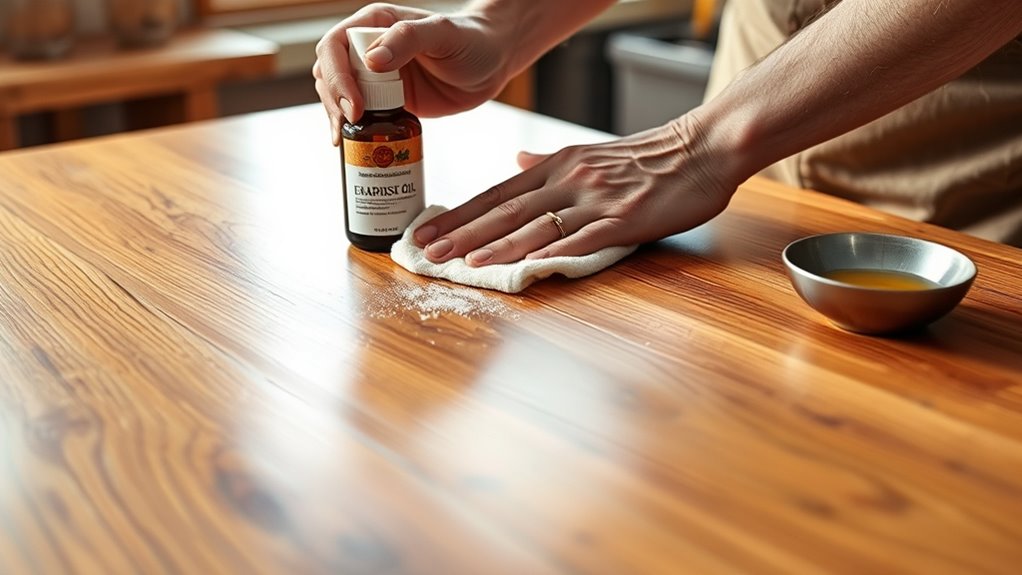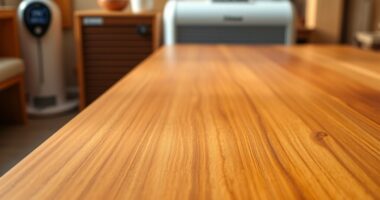To best clean wooden surfaces, use a mild dish soap and warm water for regular chores, avoiding harsh chemicals or abrasives that can harm the finish. Always dry surfaces immediately to prevent water damage, and use soft microfiber cloths for gentle dusting. Protect your wood with coasters and avoid excess water or aggressive scrubbing. Proper maintenance, such as monthly polishing and quick spill cleanup, keeps your surfaces looking great—and there’s more simple tips to help you maintain your wood beautifully.
Key Takeaways
- Use mild soap and warm water with microfiber cloths for gentle cleaning.
- Dry surfaces immediately after cleaning to prevent water damage and stains.
- Regularly dust and polish wood surfaces to maintain their appearance and protection.
- Avoid harsh chemicals, abrasive tools, and excessive water that can damage finishes.
- Protect surfaces with coasters, trivets, and mats to prevent scratches, water rings, and heat damage.

Keeping wooden surfaces clean is essential for preserving their beauty and extending their lifespan. When you care for your wood furniture and surfaces properly, you prevent damage, maintain their appearance, and guarantee they stay durable for years to come. The key is using the right cleaning methods, tools, and routines tailored to each type of wood finish.
Start by choosing gentle cleaning solutions. For most wood types, a mixture of mild dish soap and warm water works well. It’s enough to lift dirt and grime without risking damage. Avoid harsh chemicals or abrasive cleaners that can strip away the wood’s finish or cause scratches. If you’re dealing with oil-treated wood, a water-vinegar solution—equal parts water and vinegar—can do a great job at removing grime without harming the finish. To further protect your wood, consider applying appropriate cleaning products that are compatible with your wood finish, which can help preserve its natural luster and prevent deterioration.
Use mild dish soap and warm water to gently clean wood surfaces without damage.
When it comes to tools, stick with microfiber cloths. They’re gentle yet effective at removing dust and dirt without scratching. After cleaning, use soft towels or cloths to thoroughly dry the surface. Water left on wood can cause warping, discoloration, or water stains, so drying is a fundamental step.
For stubborn stains on oiled wood, fine-grade steel wool (0000 grade) can be used carefully, following the direction of the grain. Don’t use abrasive sponges or brushes—they can scratch or dull the finish. Light pressure is best when scrubbing to avoid damaging fibers or coating. Maintaining your wood surfaces regularly is indispensable. Dust your furniture weekly to prevent buildup that can scratch the surface. Clean and polish about once a month to keep the wood looking fresh and to protect its finish. Promptly wipe up spills to prevent stains, especially on untreated or unstained wood.
Using coasters and trivets helps guard against water rings and heat damage. Routine cleaning removes oils, sticky spots, and grime that dusting alone can’t handle, keeping your wood looking its best. Additionally, selecting proper cleaning products that are compatible with your wood finish will help preserve its natural luster and prevent deterioration. Incorporating appropriate cleaning techniques can further enhance the longevity of your surfaces.
Avoid common mistakes like using full-strength vinegar or alcohol, which can dry out or damage the wood. Never saturate surfaces with water—excess moisture leads to warping and discoloration. Stay away from all-purpose cleaners with silicones or harsh acids, as they leave residues and damage finishes over time.
Always dry the surface immediately after cleaning to prevent water marks. Different finishes require tailored care: unstained wood needs gentle cleaning, oiled wood benefits from mild soap and vinegar treatments, and polyurethane finishes need less frequent polishing. Use specialized cleaners or polishes designed for specific finishes to preserve shine and longevity.
Finally, protect your wood with measures like trivets, coasters, and placemats during daily use. These prevent heat, moisture, and scratches. After cleaning, applying the appropriate wood polish helps restore luster and adds a layer of protection. Regularly inspecting and maintaining your wood surfaces ensures they stay in optimal condition over the years. Following these best practices ensures your wooden surfaces stay beautiful, intact, and durable for years to come.
Conclusion
By following these best practices, you’ll keep your wooden surfaces shining like a mirror in sunlight, their natural beauty glowing with every gentle wipe. Think of your cleaning routine as tending to a delicate garden—each careful stroke preserves its charm and resilience. With a little love and the right techniques, your wood will stand proud and timeless, telling stories of care and craftsmanship through every polished grain. Keep at it, and your surfaces will forever reflect your dedication.









